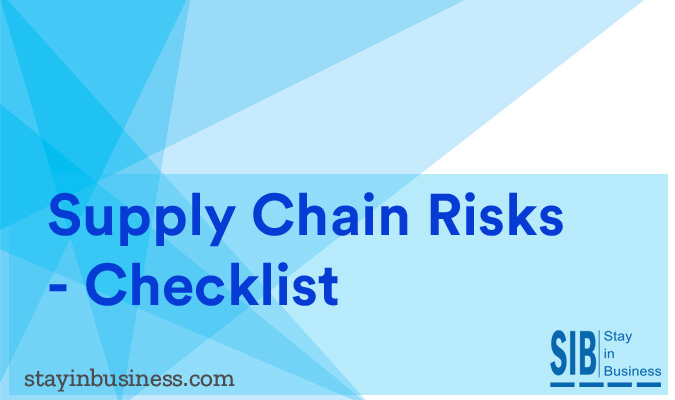
A supply chain risks checklist can enhance your organization’s supply chain risk management by detecting pain points and bottlenecks across your logistics channels for which relevant remedial measures can then be developed and deployed.
Supply Chain Risks Checklist
- Data accuracy and categorization
- Access and availability of information across the length and breadth of the supply chain
- Optimizing resource utilization in order to prevent incidents
- Central dashboard that collects, consolidates and displays all supply chain data
- Proactive approach to process management
- Periodic safety and quality checks for all major risks across the supply chain
- Receiving supplies from a single provider or location
- Periodic reviews of supply base financial health
- Regular evaluation of risks associated with expenditure, manufacturing and so on
- Handling the intricacies of supply chain networks
- Detecting the most critical vulnerability in the supply chain network
- Process driven approach for controlling supply chain risks and infrastructure
- System for duly notifying shortages and spikes in price
- Tracking drops in supplier performance
- Review of sales & operations planning, and demand management
Impediments While Responding to Supply Chain Risks
- Management reluctance owing to insufficient value addition or immediate returns
- Rigid, hierarchical planning structure that hampers adaptability
- Lack of precise data, resources and exhaustive risk mitigation strategies
- Corporate guidelines
- Access to suppliers’ information repositories
- Lack of control over risks associated with outsourced resources
- Insufficient staffing at the tactical/execution level
- Complacency
Evaluating Criteria for Your Supply Chain Risks Checklist
The different entries listed in your supply chain risk management checklist can be rated based on their impact on operations as well as probability of occurrence. You can calibrate the impact on operations as per the specific needs of your business, such as
Trivial – Barely any impact on operations
Low – Mild slowdown in production
Moderate – Visible drop in production output
High – Operations are severely affected at this level
Catastrophic – Business processes are brought to a standstill
Similarly, the probability of occurrence can be classified based on the likelihood of supply chain risks such as
Highly Unlikely – Once in many years
Unlikely – Once in many months
Possible – Once in many weeks
Very Possible – Occurs every week
Will Definitely Occur – Occurs every day
Supply chain risks checklist entries with
- High impact and high likelihood must be terminated
- High impact and low likelihood must be transferred
- Low impact and high likelihood must be treated
- Low impact and low likelihood must be tolerated
Supply Chain Risk Factors
- Quantitative – Revenue, Income and Cash flow
- Qualitative – Reputation, Regulations and Strategies
Supply Chain Risks without Insurance Cover
- Underperforming suppliers
- Unpredictable and erratic customer requirements
- Stalled operations owing to discord with partners
- Recalls due to faulty products
- Emerging Risks
- Others
Supply Chain Risks for which Insurance is Available
- Catastrophes
- Damage to property and losses
- Product liability
- Business Interruption
Cause & Effect Assessment
- Falling back on Delivery Deadlines
- Lack of stock
- Issues supplying raw materials
- Insufficient capacity
- Failure to meet targets
- Carrier performance
- Ineffective communication
- Lack of proper scheduling
- Very short lead times
- Rigid systems
- Forecasting issues
- Quality concerns
- Ineffective process control
- Insufficient supplier management
See for yourself how the application works
Witness our cloud based platform’s security capabilities in action
Play around with the software and explore its features
Compare and choose a solution that’s relevant to your organization
Consult our experts and decide on a pricing mechanism




